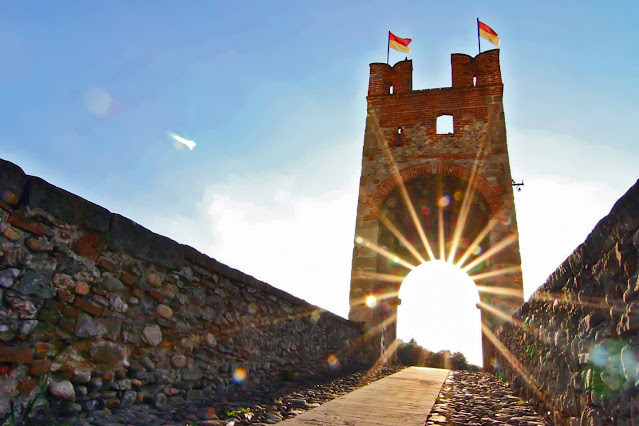Millesimo, 1,000 emotions and truffle scents
 |
| Millesimo, the fortified Gaietta bridge |
Located in the entroterra of the Province of Savona, Millesimo (not
surprisingly) belongs to the Borghi
più Belli d’Italia (Most
Beautiful Villages in Italy) circuit. The origin of this little gem of history
and gastronomy dates back to Roman times when it acted as a stronghold along
the Via Aemilia Scauri consular route.
The centre, dominated by the del Carretto Castle (complete with Napoleonic Museum) on one side and the Palazzo Comunale on the other (do not miss its splendid sundial), can also be suggestively accessed from the fortified Gaietta bridge. There, stroll unhurriedly under the medieval porticoes, still dotted with ancient shops and delis. Cycling fans can pedal their way to Cossèria (with the late Luciano Berruti's Bicycle Museum) and on to Carcare along the cycling path. Just outside the centre, the austere Santa Maria extra muros, a Romanesque parish church restored in the 1960s; a few kilometres toward Murialdo, rapid hairpin bends lead to the Sanctuary of the Madonna del Deserto, a devotional venue as well as the starting point of many hike&bike itineraries.
In Liguria, Millesimo evokes
truffles: a lively autumn festival, recognised in 2018 at the national level
and this year at its 30th edition, divulges them with a market, hunting moments
(truffle hunting and extraction entered Unesco heritage list in 2021),
exhibitions and conferences, edutainment and thematic menus (bon appetit!).
In the Bormida Valley, truffles go traditional on fried eggs, but - as is well
known - they are always fabulous with carpaccio, tajarin, risotto, fondue (and
on the other hand, the local cuisine wedges towards the Piedmontese Langhe). As
for wine pairings, truffles usually match aromatic wines, the classic being
Gewürztraminer, to be served at 10-11°C in tall-stemmed glasses.
What else? Well, Millesimo is
also bakery wisdom. Butcher shops display sausages, raw salami, cotechini, and tripe.
Zuncò (dairy product obtained from curdled milk)
comes from cow's milk. From bee-keeping came and still comes honey for fragrant
hazelnut cakes (but the woods also offered high-protein snails). In the fields
of the Santo Stefano monastery grow the indigenous hops and distichous barley
necessary for the 'Confine' beer available in Coop supermarkets. Saffron is
cultivated in Montecala, near Cossèria.
Finally, an elegant packet of
rum-flavoured Millesini will be more than just a gourmet souvenir.
My English abstract of Umberto
Curti's article as published in Liguria Food
This is the fascinating world of
tastes and crafts that LiguriabyLuisa discloses to foreign markets and buyers
(tour operators, travel agencies, organizations, associations, food&wine
dealers and import/export professionals....).
Would you like to know more? Contact me and detail your queries


Comments
Post a Comment